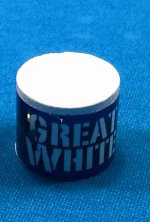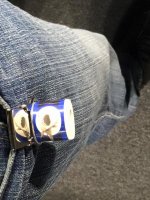The peanut butter Analogy.....
Would you ever put peanut butter on the end of your cue to play pool? Of course you wouldn't... well maybe on a bet but still not likely....
The reason I am asking that question is to give you a model that everyone can relate to....
Where chalk is made up of binders, fillers, Dyes and Abrasives Peanut Butter is pretty simple... Oil, Salt, Sugar and ground Peanuts....
The binders in chalk act like the oils in peanut butter... They keep the mixtures together and have the job of helping each go on smooth.....
The fillers in chalk are kind of like adding salt to peanut butter... It adds to the mix but too much of either will be a bad thing... In chalk you will get a lower quality chalk.. In peanut butter you will get high blood pressure.....
The Dyes in the chalk are like adding sugar or molasses to the peanut butter.. Neither make it perform differently going on the bread but to some people they make it look better(chalk) or taste better (peanut butter)
Last ingredients are the Ground Peanuts or the Abrasives.... These are the key in each product... the amount of peanuts and the size of the peanuts determine crunchy vs creamy.... While some people like both kinds you do not want the creamy peanut butter version of chalk...
The abrasives in the chalk have to be plentiful and large enough to get a bite on the cueball.. So you need the crunchy version for it to perform well.. The crunchier it is the more shots you can shoot before it turns into the creamy version which will just slip off the tip and misscue... Compressing the chalk between the tip and the cueball is equivalent to chewing the peanuts... Each time you chew you crush the peanuts just like every shot crushes and ruptures the abrasives in chalk..
The basic chalks already are on their way to being the creamy version because the abrasive size and quantity is considerably less And in some instances you get a layer of chalk on your tip that was creamy to start with and have almost no pieces of peanut that are large enough to matter.. Everyone has chalked up and immediately misscued while putting a good stroke on the ball. That is why is happens even if it is rare.
You have 2 ways to get crunchier peanut butter, the same as performance chalk..... You either use more peanuts or you use larger pieces of peanut...
In all of the performance chalks I have looked at the size and quantity is greater than you find in the lower priced chalks.... And aside from Lava chalk all of the premiums use hard, mahs scale 9, Abrasives......
The reason that using harder peanuts won't work is 2 fold... Harder abrasives will actually cause scratches to the cueball and even if used the fact that the abrasives are layered on top of each other means that the abrasives will fracture each other... They use diamonds to cut diamonds....
This is the entire reason I tell people to use a premium chalk... ALL of the premium chalks have adequate abrasives in size and quantity to do the job...
Premium chalks are all going to make it thru a full rack without misscue... So what if I can shoot 50 shots before I chalk with Great White... Waiting until you misscue to chalk is not how anyones decides when to chalk......
Choose your Premium Chalk based on YOUR personal preference... Some go on easier, some feel different going on, Some are cleaner, Some are made here in the US. 2 are Cosmetic Grade. One is $30 a cube.. I hope you choose ours but if you don't that's ok as long as you are using another premium...
I developed the Great White as an affordable chalk that was made from the best quality materials available... I made it white because I hate getting blue all over my cue, hands and clothes... I formulated it to have the proper sizes and amounts of abrasives so you can trust it and not have a gritty feel... I made it here in the US because everything Outsville makes is here in Knoxville, TN...
Beware of ANYONE claiming any brand is the best when they are talking chalk... We won't claim to be the best even if I think we are because there are too many benchmarks and too many subjective measurements... We may be use the highest quality materials does that make us the best? Is White better than Blue? If you can shoot 100 shots without a misscue will that crown the best? How about who lasts the longest before the cube wears out? Who sells the most? How about the instance where you have a knockoff that's the same as the original? IS the Knockoff the best because it is cheaper or is the original the best because they invented/formulated it?
It comes down to what YOU think works best for you.... And what you LIKE the best... If you already have a premium chalk that you love stick with it... It's all good stuff... If you are still looking all I can say is I hope you give us a look while you are evaluating....
Just realize it will take 30 days of a good chalking habit with a premium chalk before you will train your brain to truth the connection and start letting you get outside of your comfort zone or current misscue limit
.....

